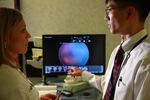
Michael Chiang reviews images of the eyes of premature babies who were sent to him via the telemedicine program at OHSU for ROP monitoring and diagnosis.
OHSU
An artificial intelligence system is better than most experts at diagnosing a childhood blindness disease, according to a new study from Oregon Health and Science University.
Retinopathy of prematurity, or ROP, is a disease that can cause blindness in premature babies. It's how the musician Stevie Wonder lost his sight.
To diagnose ROP, doctors have to examine the back of the eye and see whether the blood vessels are overly dilated or wiggly. It’s difficult to diagnose, and to make matters worse, if doctors don't catch it early a child could be blind for the rest of their life.
But now, a team of scientists from OHSU and Massachusetts General Hospital has put together a computer system that compares an image of a patients' retina against a library of healthy and ROP images. It then uses a system of deep-learning to deliver a diagnosis.
The algorithm accurately diagnosed the condition 91 percent of the time. That's compared to a team of eight ROP experts who managed an accuracy rate of 82 percent.
Dr. Michael Chiang, a professor of ophthalmology at OHSU, says there's a huge shortage of people trained to diagnose ROP and this algorithm could help.
“Our overall goal with this is to be able to try to use tools like this to help doctors take better care of patients. I think there are a lot of ways that we can do that, but they all boil down to testing this in more babies, making sure it works as well as we think it does.”
Chiang's colleague, Jayashree Kalpathy-Cramer with Massachusetts General Hospital, has similar hopes. "This algorithm distills the knowledge of ophthalmologists who are skilled at identifying ROP and puts it into a mathematical model so clinicians who may not have that same wealth of experience can still help babies receive a timely, accurate diagnosis," she said.

Jayashree Kalpathy-Cramer with Massachusetts General Hospital, thinks that in the future, doctors may be like pilots who rely on autopilots. Passengers are comfortable with autopilots, but they’re happy there’s a human to take over when necessary. Doctors are likely to use deep-learning algorithms to confirm tricky diagnoses, but also be available when necessary.
OHSU
Last month, the U.S. Food and Drug Administration approved an artificial intelligence device to detect diabetes-related eye disease.
Doctors say there’s no reason such artificial intelligence system can’t be used to diagnose other diseases too.
Kalpathy-Cramer said in the future, doctors may be like pilots who rely on autopilots. Passengers are comfortable with autopilots, but they’re happy there’s a human to take over when necessary. Doctors are likely to use deep-learning algorithms to confirm tricky diagnoses, but they'll also be available when necessary.
ROP is the leading cause of childhood blindness globally. There are two basic treatments. One involves drugs injected into the eye, the other lasers. Both treatments work well, but they have to be used early before the damage becomes permanent.
The National Institutes of Health estimate that in the U.S. up to 16,000 babies a year experience ROP. About 600 become permanently blind.
The study on artificial intelligence is being published in the latest edition of JAMA Ophthalmology. It was supported by the National Institutes of Health, the National Science Foundation, Research to Prevent Blindness, and the Oregon State Elks.
